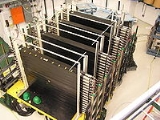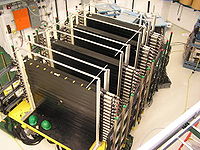
Modular Neutron Array
Encyclopedia

Michigan State University
Michigan State University is a public research university in East Lansing, Michigan, USA. Founded in 1855, it was the pioneer land-grant institution and served as a model for future land-grant colleges in the United States under the 1862 Morrill Act.MSU pioneered the studies of packaging,...
's National Superconducting Cyclotron Laboratory
National Superconducting Cyclotron Laboratory
National Superconducting Cyclotron Laboratory is located on the campus of Michigan State University and is the leading rare isotope research facility in the United States...
(NSCL), a nuclear physics research facility. It is specifically designed for detecting neutrons stemming from breakup reactions of fast fragmentation beams.
The MoNA Detector Array
The Modular Neutron Array consists of 144 individual detector modules. Each module is based on a plastic scintillatorScintillator
A scintillator is a special material, which exhibits scintillation—the property of luminescence when excited by ionizing radiation. Luminescent materials, when struck by an incoming particle, absorb its energy and scintillate, i.e., reemit the absorbed energy in the form of light...
measuring 10 cm by 10 cm by 200 cm. This scintillator bar is fitted with light guides on each end that direct the light into one photo-multiplier tube on each end. Each detector module is wrapped in a light-tight material, allowing the detector array to be arranged in different configurations.
In its original configuration, MoNA consisted of 9 vertical layers of 16 detectors stacked closely, having an active area of 2.0 m wide by 1.6 m tall. In its current arrangement (depicted in the image to the right), it is stacked in four separate sections of 2, 2, 2, and 3 layers each, respectively, separated by spaces ranging from 0.5 to 0.8 meters. It measures both the position and time of neutron events with multiple-hit capability. The energy of a neutron is based on a time-of-flight measurement. This information together with the detected position of the neutron is used to construct the momentum vector of the neutrons.
The detection efficiency of MoNA is maximized for the high-beam velocities that are available at the NSCL's Coupled Cyclotron Facility (CCF). For neutrons ranging from 50 to 250 MeV
MEV
MeV and meV are multiples and submultiples of the electron volt unit referring to 1,000,000 eV and 0.001 eV, respectively.Mev or MEV may refer to:In entertainment:* Musica Elettronica Viva, an Italian musical group...
in energy, it is designed to have an efficiency of up to 70% and expands the possible coincidence experiments with neutrons to measurements which were previously not feasible. The detector is used in combination with the Sweeper magnet and its focal plane detectors for charged particles. In addition, MoNA’s modular design allows it to be transported between experimental vaults and thus to be used in combination with the Sweeper magnet installed at the S800 magnet spectrograph. Due to its high-energy detection efficiency, this detector will be well suited for experiments with fast fragmentation beams at the proposed ISF.
History
When the NSCL upgraded their capabilities to the Coupled Cyclotron facility, a Florida State UniversityFlorida State University
The Florida State University is a space-grant and sea-grant public university located in Tallahassee, Florida, United States. It is a comprehensive doctoral research university with medical programs and significant research activity as determined by the Carnegie Foundation...
/Michigan State University consortium built the Sweeper magnet to be used with two existing neutron walls to perform neutron–fragment coincidence experiments. The neutron walls were originally built for lower beam energies and had only an efficiency of about 12% for the neutron energies expected from the CCF. During the 2000 NSCL users meeting, a working group realized the opportunity to significantly enhance the efficiency with an array of more layers using plastic scintillator detectors
Scintillator
A scintillator is a special material, which exhibits scintillation—the property of luminescence when excited by ionizing radiation. Luminescent materials, when struck by an incoming particle, absorb its energy and scintillate, i.e., reemit the absorbed energy in the form of light...
.
Several NSCL users from undergraduate schools were present at the working group meeting and they suggested that the modular nature and simple construction would offer great opportunities to involve undergraduate students.
In the spring of 2001, the idea evolved into several MRI proposals submitted by 10 different institutions, most of them undergraduate schools. The proposals were funded by the NSF in the summer of 2001. Following the detailed design, the first modules of the detector array were delivered in the summer of 2002. During the following year all modules were assembled and tested by undergraduate students at their school, and finally added to form the complete array at the NSCL.
The MoNA collaboration continued after the initial phase of construction and commissioning was concluded [MoNA], and is now using the detector array for experiments, giving a large number of undergraduate students from all collaborating schools the opportunity to take part in cutting-edge nuclear physics experiments at one of the world’s leading rare-isotope facilities. The research at the undergraduate institutions is funded by the NSF through several RUI (Research at Undergraduate Institutions) grants.
The MoNA Collaboration
The MoNA project is a collaboration between ten colleges and universities that originally constructed the highly efficient large-area neutron detector for the detection of high-energy neutrons to be used in experiments with fast rare isotopes at the NSCL. The project is funded by the National Science FoundationNational Science Foundation
The National Science Foundation is a United States government agency that supports fundamental research and education in all the non-medical fields of science and engineering. Its medical counterpart is the National Institutes of Health...
.
The members of the collaboration are:
- Central Michigan UniversityCentral Michigan UniversityCentral Michigan University is a public research university located in Mount Pleasant in the U.S. state of Michigan...
- Concordia College at Moorhead
- Florida State UniversityFlorida State UniversityThe Florida State University is a space-grant and sea-grant public university located in Tallahassee, Florida, United States. It is a comprehensive doctoral research university with medical programs and significant research activity as determined by the Carnegie Foundation...
- Hope CollegeHope CollegeHope College is a medium-sized , private, residential liberal arts college located in downtown Holland, Michigan, a few miles from Lake Michigan. It was opened in 1851 as the Pioneer School by Dutch immigrants four years after the community was first settled...
- Indiana University South BendIndiana University South BendIndiana University South Bend is the third largest campus of the Indiana University system. It is popularly known as IUSB or IU South Bend. It is located in South Bend, Indiana, in St. Joseph County, Indiana.-History:...
- Marquette UniversityMarquette UniversityMarquette University is a private, coeducational, Jesuit, Roman Catholic university located in Milwaukee, Wisconsin. Founded by the Society of Jesus in 1881, the school is one of 28 member institutions of the Association of Jesuit Colleges and Universities...
- Michigan State UniversityMichigan State UniversityMichigan State University is a public research university in East Lansing, Michigan, USA. Founded in 1855, it was the pioneer land-grant institution and served as a model for future land-grant colleges in the United States under the 1862 Morrill Act.MSU pioneered the studies of packaging,...
- Wabash CollegeWabash CollegeWabash College is a small, private, liberal arts college for men, located in Crawfordsville, Indiana. Along with Hampden-Sydney College and Morehouse College, Wabash is one of only three remaining traditional all-men's liberal arts colleges in the United States.-History:Wabash College was founded...
- Western Michigan UniversityWestern Michigan UniversityWestern Michigan University is a public university located in Kalamazoo, Michigan, United States. The university was established in 1903 by Dwight B. Waldo, and as of the Fall 2010 semester, its enrollment is 25,045....
- Westmont CollegeWestmont CollegeWestmont offers 26 majors, including: alternative major, art, biology, chemistry, communication studies, computer science, economics and business, education program, engineering physics, English, history, European studies, kinesiology, liberal studies, mathematics, modern languages , music,...
The collaboration is committed to involving undergraduates in significant parts of the experimental program at the MoNA facility. Most of the collaboration member institutions are primarily undergraduate schools. Undergraduates helped construct and test MoNA and continue to participate in experiments during runs and through data analysis. It also created intensive summer sessions designed for undergraduates, encouraging students to participate in all phases of experiments, holding several meetings a year that include undergraduate participants, and employing information technology to bring the distant undergraduate students together.

